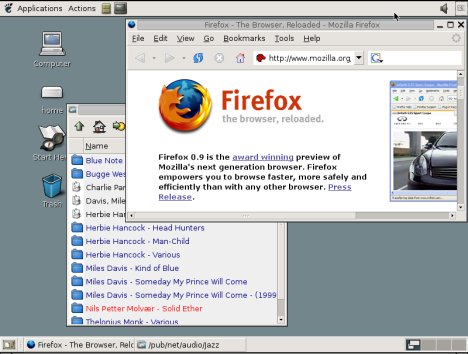A beginners guide to Linux for those with little or no computer experience.
1. What is Linux?
Linux is a free Unix-type operating system for computer devices. The operating system is what makes the hardware work together with the software. The OS is the interface that allows you to do the things you want with your computer. Linux is freely available to everyone.OS X and Windows are other widely used OS. 
Linux gives you a graphical interface that makes it easy to use your computer, yet it still allows those with know-how to change settings by adjusting
0 to 1. It is only the kernel that is named Linux, the rest of the OS are GNU tools. A package with the kernel and the needed tools make up a
Linux distribution. Mandrake , SUSE Linux, Gentoo and Redhat are some of the many variants. GNU/Linux OS can be used on a large number of boxes, including i386+ , Alpha, PowerPC and Sparc. 2. Understanding files and folders
Linux is made with one thought in mind: Everything is a file.A blank piece of paper is called a file in the world of computers. You can use this piece of paper to write a text or make a drawing. Your text or drawing is called information. A computer file is another way of storing your information.
If you make many drawings then you will eventually want to sort them in different piles or make some other system that allows you to easily locate a given drawing. Computers use folders to sort your files in a hieratic system.
A file is an element of data storage in a file system. Files are usually stored on harddrives, cdroms and other media, but may also be information stored in RAM or links to devices.
To organize our files into a system we use folders. The lowest possible folder is root / where you will find the user homes called /home/.
/
/home/
/home/mom/
/home/dad/
Behind every configurable option there is a simple human-readable text file you can hand-edit to suit your needs. These days most programs come with nice GUI (graphical user interface) like Mandrakes Control Center and Suses YAST that can smoothly guide you through most configuration. Those who choose can gain full control of their system by manually adjusting the configuration files from foo=yes to foo=no in an editor.
Almost everything you do on a computer involves one or more files stored locally or on a network.
Your filesystems lowest folder root / contains the following folders:
| /bin | Essential user command binaries (for use by all users) |
| /boot | Static files of the boot loader, only used at system startup |
| /dev | Device files, links to your hardware devices like /dev/sound, /dev/input/js0 (joystick) |
| /etc | Host-specific system configuration |
| /home | User home directories. This is where you save your personal files |
| /lib | Essential shared libraries and kernel modules |
| /mnt | Mount point for a temporarily mounted filesystem like /mnt/cdrom |
| /opt | Add-on application software packages |
| /usr | /usr is the second major section of the filesystem. /usr is shareable, read-only data. That means that /usr should be shareable between various FHS-compliant hosts and must not be written to. Any information that is host-specific or varies with time is stored elsewhere. |
| /var | /var contains variable data files. This includes spool directories and files, administrative and logging data, and transient and temporary files. |
| /proc | System information stored in memory mirrored as files. |
The only folder a normal user needs to use is
/home/you/ - this is where you will be keeping all your documents. /home/elvis/Documents
/home/elvis/Music
/home/elvis/Music/60s
Files are case sensitive, "myfile" and "MyFile" are two different files.
For more details, check out:
3. Understanding users and permissions
Linux is based on the idea that everyone using a system has their own username and password.Every file belongs to a user and a group, and has a set of given attributes (read, write and executable) for users, groups and all (everybody).
A file or folder can have permissions that only allows the user it belongs to to read and write to it, allowing the group it belongs to to read it and at the same time all other users can't even read the file.
4. Who and what is root
Linux has one special user calledroot (this is the user name). Root is the "system administrator" and has access to all files and folders. This special user has the right to do anything. You should never log on as this user unless you actually need to do something that requires it!
Use
su - to temporary become root and do the things you need, again: never log into your sytem as root! Root is only for system maintenance, this is not a regular user (LindowsOS don't have any user management at all and uses root for everything, this is a very bad idea!).
You can execute a command as root with:
su -c 'command done as root' Gentoo Linux: Note that on Gentoo Linux only users that are member of the wheel group are allowed to su to root.
In The Next Article I Will Post How To Install Linux.


No comments:
Post a Comment